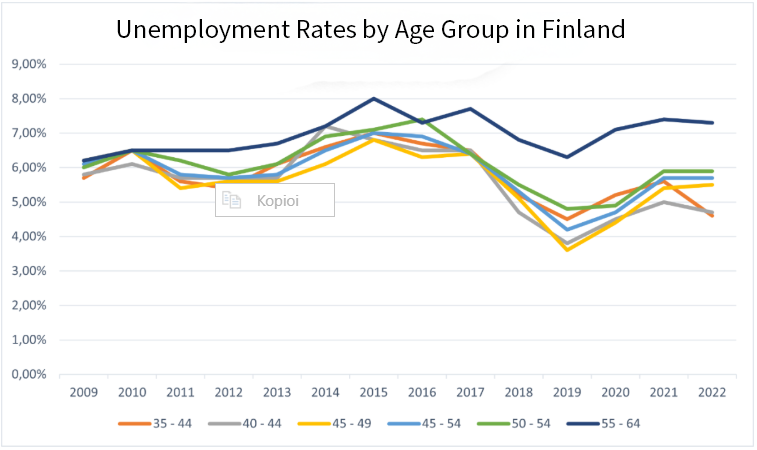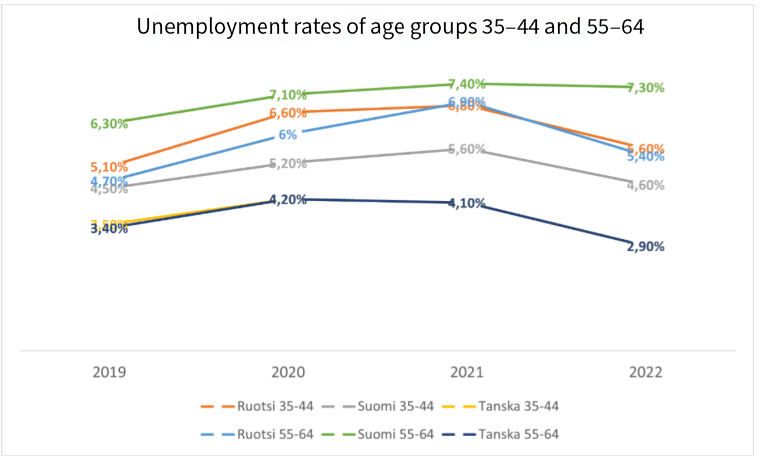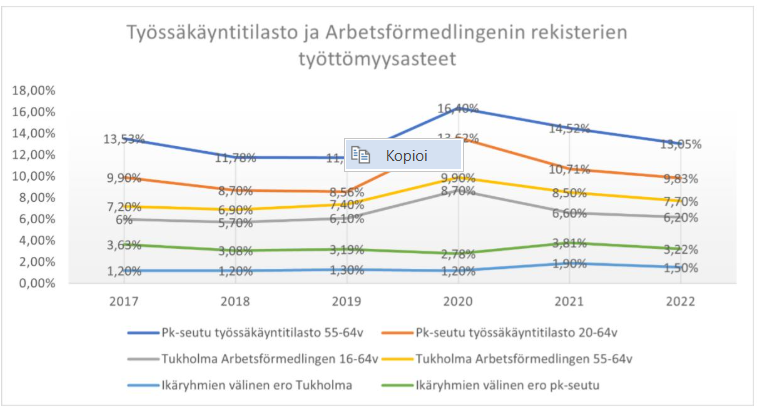THIS BLOG’S THEME: AGE DISCRIMINATION
The employment challenge concerning people over 55 is one of the main problems facing the Finnish labour market. Age discrimination can easily become a self-fulfilling prophesy. Why, for example, is re-employment more difficult for people aged 55 and over, compared with younger age groups?
In January 2024, the Finnish centre for Pensions published interesting findings revealing that employers experiencing recruitment difficulties are no more interested in hiring over-55s than other employers.
According to the Finnish Institute of Occupational Health, negative attitudes towards age affect the careers of people over 55. According to the Finnish Social Insurance Institution Kela, the older an unemployed jobseeker is, the less chance they have of re-employment.
Statistics show that, in Finland, the unemployment rate of people aged 55 and over has long been higher than that of other age groups (Figure 1). For example, Statistics Finland’s blog explores the fact that people aged 55 and over do not become unemployed more often than younger age groups, but that it is more difficult for them to re-enter the labour market.

Age discrimination affects young people, too
Is the over-55s employment challenge one of the main problems facing the Finnish labour market?
At The Ami Foundation, our vision is for the Helsinki Metropolitan Area to have the best labour market in the Nordic countries. This is why we want to highlight the high unemployment rate among the over-55s age group, alongside the factors contributing to it. It is important to discuss this issue and to produce further research.
Diversity in the labour market is one of The Ami Foundation’s programme priorities. No one should experience discrimination in their working life or during their job search because of their age. Age diversity has been shown to increase diversity in the workplace.
Addressing the employment challenges of more mature jobseekers is also important because this sustainability gap is challenging Finland’s public finances, and contributing to the pressure to extend people’s working lives at a time when re-employment becomes challenging just before retirement age.
This blog refers to the 55–64 age group for statistical reasons. However, employment challenges are even more broadly applicable to jobseekers over 50 years of age.
Age discrimination does not only affect those with long careers, but also young workers who find it difficult to establish themselves in the labour market early in their careers. The challenges of youth employment were discussed The Pathfinder blog on NEET youth.

Age discrimination can be invisible to jobseekers
Employers may have incorrect assumptions about the health, skills, and motivation of older jobseekers. It is also typical to imagine that older workers suffer more from ill health, or lack motivation, in their last years of work before retirement.
Incorrect perceptions guide recruitment activities. Age discrimination can already start with the job ad, which can imply that a younger person is being sought for the job. This may in turn mean that an older person does not feel that they could be the right fit for the job.
Similarly, employers may exclude certain age groups from the people invited for an interview.
Age discrimination in the labour market can easily become a self-fulfilling prophesy. Age discrimination also creates an impression of a labour market in which older job seekers do not get employed.
For example, according to the Finnish Institute of Occupational Health, older workers experience more work satisfaction and independence and less monotony than younger workers. One explanatory factor may also be the attitude of younger managers towards older workers or, in particular, their recruitment.
We at The Ami Foundation are very interested in research into the reasons for employment challenges faced by the over-55s, and projects that could support their re-employment. We are also interested in perspectives that open up new ways of thinking.
People aged 55–64 are most affected by age discrimination
In Finland, the unemployment rate of people aged 55–64 has long been higher than that of younger age groups. After the financial crisis of 2008–2009, the unemployment rate in the working age population as a whole also rose to a higher level than in the other Nordic countries.
Given Finland’s poor performance, a wholesale comparison of the unemployment rate of 55–64-year-olds between the Nordic capital regions is not very fruitful, and does not provide an overall picture of the situation.
Differences in national registers and statistics must also be considered. Unemployment may be defined differently in different registers, depending on the country. Within a country, different statistics also produce very different unemployment figures. In Finland, for example, the Labour Force Survey, Employment Service Statistics, and Employment Statistics all give different figures on unemployment rates.
The Labour Force Survey (LFS) is a sample-based survey, and its classification of unemployment is quite strict. However, internationally, Labour Force Survey results are considered comparable, as similar LFS’s are carried out in other EU countries.
However, differences in unemployment rates between different age groups can also be explored through the registers of different countries, when the aim is to examine the relationship between the employment rate of 55–64-year-olds and the unemployment rate in younger age groups.
Comparing the country-specific LFS unemployment rates for Finland, Sweden and Denmark, for example, in the 35–44 and 55–64 age groups, we can see that Finland has a clearly elevated unemployment rate of over-55s (Figure 2). In Denmark and Sweden, the difference in
unemployment rates between the two age groups is not at all as large. In Denmark, LFS results do not show any difference between the age groups.

A closer look at the data for Nordic capital regions
We have compared unemployment rates in the 55–64 age group in the capital regions of Finland, Sweden, Norway, Denmark, and Estonia. The data have been obtained from the national authorities, and we have also received consultancy support from researchers at the respective statistics offices.
To the best of our knowledge, no similar comparative data on capital regions has been collected previously in Finland. We would be interested to hear about similar experiments.
Obtaining statistics for the Oslo-Viken area proved more difficult than expected. We obtained advice from researchers at the Norwegian Labour and Welfare Administration (NAV).
The data from the Swedish Public Employment Service Arbetsförmedlingen, which is similar to the Finnish employment services authority TE-palvelut, differ slightly from the data provided by Statistics Sweden (SCB). Statistic Sweden’s data on unemployment differ from Arbetsförmedlingen’s data in the same way as the different unemployment statistics within Finnish authorities.
Finnish capital region
According to Statistics Finland’s employment statistics, the unemployment rate in the Finnish capital region in the 18–64 age group has fluctuated between 9% and 13% between 2017 and 2022.
According to the same statistics, the unemployment rate in the 55–64 age group has fluctuated between 12% and 16% between 2017 and 2022. In other words, the unemployment rate in this group has remained 3% higher than in the 18–64 age group (based on employment statistics figures).
A similar situation can be seen at a national level in the Labour Force Survey figures which were visualised at the beginning of this blog (Figure 1). Similar figures can be found in the data from the Ministry of Economic Affairs and Employment of Finland’s employment statistics. They show that, in Finland, the unemployment rate of people aged 55–64 is 3–4% higher than in the age group 20–64.
Swedish capital region
In Sweden, the unemployment rate of people aged 16–64 has remained at around 6.5% between 2017 and 2023. Similarly, the unemployment rate of people aged 55–64 has been around 7.5%, just one percentage point higher than that of people aged 16–64.
In Statistic Sweden’s register data, unemployment rates in the age groups 20–64 and 55–64 are 1–2% lower than in Arbetsförmedlingen’s data. Statistic Sweden’s register data show that the difference in unemployment rates between age groups over the last five years has been around 1%, with the unemployment rate in the 55–64 age group 1% higher (Figure 3).
It can therefore be said that the unemployment rate of people aged 55–64 in Stockholm County is at the same level as the unemployment rate in the working-age population as a whole, unlike in the Finnish capital region.


Norwegian capital region
Oslo-Viken statistics were not available in the 55–64 age group as a whole, but we received statistics in the 50–59 and 60–69 age groups separately.
Norway is known to have one of the lowest unemployment rates in Europe.
Unemployment in the Oslo-Viken area also appears very low in the 50–59 and 60–69 age groups, with figures remaining at around 2% over the last seven years.
According to Statistics Norway (SSB), the unemployment rate in the working-age population in Oslo-Viken has been around 3% in recent years, higher than in the 50–59 and 60–69 age groups, according to data provided to us by the Norwegian Labour and Welfare Administration.
Danish capital region
According to Statistics Denmark’s register-based data, the unemployment rate in Copenhagen (Region Hovedstaden) has remained below 4%.
In the 55–59 age group, the unemployment rate has been consistently lower than in the working age population as a whole.
The unemployment rate of over-60s has also only been approx. 1% higher than in the working-age population as a whole.
While there may be differences in the compilation of the figures due to country-specific statistics, the comparison shows a clear difference between the Finnish capital region and other Nordic capital regions.
Tallinn region
In Tallinn, according to data from Statistics Estonia, the unemployment rate in the 55–64 age group has remained practically identical to the 20–64 age group.
It is noteworthy that, during 2019 and 2022, the unemployment rate in the 55–64 age group had fallen to even lower levels than in the 20–64 age group.
Sources and reading tips
Finnish Occupational Health Institute bulletin on negative age attitudes faced by 55-year-olds
City of Vantaa’s project Kohtaanto +50 -hanke on matching skills and needs (2023–2025)
Kela research publication Getting older unemployed people back to work (2019) [not translated]
